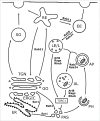Small GTPases controlling autophagy-related membrane traffic in yeast and metazoans
- PMID: 28005455
- PMCID: PMC6205004
- DOI: 10.1080/21541248.2016.1258444
Small GTPases controlling autophagy-related membrane traffic in yeast and metazoans
Abstract
During macroautophagy, the phagophore-mediated formation of autophagosomes and their subsequent fusion with lysosomes requires extensive transformation of the endomembrane system. Membrane dynamics in eukaryotic cells is regulated by small GTPase proteins including Arfs and Rabs. The small GTPase proteins that regulate autophagic membrane traffic are mostly conserved in yeast and metazoans, but there are also several differences. In this mini-review, we compare the small GTPase network of yeast and metazoan cells that regulates autophagy, and point out the similarities and differences in these organisms.
Keywords: Arf; Rab; Rag; TORC1; autolysosome; autophagosome; autophagy; membrane fusion; membrane trafficking.
Figures

Similar articles
-
Small GTPase proteins in macroautophagy.Small GTPases. 2018 Sep 3;9(5):409-414. doi: 10.1080/21541248.2016.1246280. Epub 2016 Nov 1. Small GTPases. 2018. PMID: 27763811 Free PMC article. Review.
-
Ypt/Rab GTPases: principles learned from yeast.Crit Rev Biochem Mol Biol. 2015;50(3):203-11. doi: 10.3109/10409238.2015.1014023. Epub 2015 Feb 23. Crit Rev Biochem Mol Biol. 2015. PMID: 25702751 Free PMC article. Review.
-
Role of Rab GTPases in membrane traffic.Int Rev Cytol. 1997;176:1-85. doi: 10.1016/s0074-7696(08)61608-3. Int Rev Cytol. 1997. PMID: 9394917 Review.
-
Autophagy and proteins involved in vesicular trafficking.FEBS Lett. 2015 Nov 14;589(22):3343-53. doi: 10.1016/j.febslet.2015.09.021. Epub 2015 Oct 9. FEBS Lett. 2015. PMID: 26450776 Review.
-
Membrane Trafficking in Autophagy.Int Rev Cell Mol Biol. 2018;336:1-92. doi: 10.1016/bs.ircmb.2017.07.001. Epub 2017 Sep 21. Int Rev Cell Mol Biol. 2018. PMID: 29413888 Review.
Cited by
-
Pathogenic Single Nucleotide Polymorphisms on Autophagy-Related Genes.Int J Mol Sci. 2020 Nov 2;21(21):8196. doi: 10.3390/ijms21218196. Int J Mol Sci. 2020. PMID: 33147747 Free PMC article. Review.
-
Developmental program-independent secretory granule degradation in larval salivary gland cells of Drosophila.Traffic. 2022 Dec;23(12):568-586. doi: 10.1111/tra.12871. Traffic. 2022. PMID: 36353974 Free PMC article.
-
The entry of unclosed autophagosomes into vacuoles and its physiological relevance.PLoS Genet. 2022 Oct 13;18(10):e1010431. doi: 10.1371/journal.pgen.1010431. eCollection 2022 Oct. PLoS Genet. 2022. PMID: 36227834 Free PMC article.
-
Role of Rab GTPases in Hepatocellular Carcinoma.J Hepatocell Carcinoma. 2021 Nov 19;8:1389-1397. doi: 10.2147/JHC.S336251. eCollection 2021. J Hepatocell Carcinoma. 2021. PMID: 34824998 Free PMC article. Review.
-
The where, what, and when of membrane protein degradation in neurons.Dev Neurobiol. 2018 Mar;78(3):283-297. doi: 10.1002/dneu.22534. Epub 2017 Sep 19. Dev Neurobiol. 2018. PMID: 28884504 Free PMC article. Review.
References
-
- Mizushima N, Levine B, Cuervo AM, Klionsky DJ. Autophagy fights disease through cellular self-digestion. Nature 2008; 451:1069-75; PMID:18305538; http://dx.doi.org/10.1038/nature06639 - DOI - PMC - PubMed
-
- Sancak Y, Peterson TR, Shaul YD, Lindquist RA, Thoreen CC, Bar-Peled L, Sabatini DM. The Rag GTPases bind raptor and mediate amino acid signaling to mTORC1. Science 2008; 320:1496-501; PMID:18497260; http://dx.doi.org/10.1126/science.1157535 - DOI - PMC - PubMed
-
- Kira S, Tabata K, Shirahama-Noda K, Nozoe A, Yoshimori T, Noda T. Reciprocal conversion of Gtr1 and Gtr2 nucleotide-binding states by Npr2-Npr3 inactivates TORC1 and induces autophagy. Autophagy 2014; 10:1565-78; PMID:25046117; http://dx.doi.org/10.4161/auto.29397 - DOI - PMC - PubMed
-
- Kim E, Goraksha-Hicks P, Li L, Neufeld TP, Guan KL. Regulation of TORC1 by Rag GTPases in nutrient response. Nat Cell Biol 2008; 10:935-45; PMID:18604198; http://dx.doi.org/10.1038/ncb1753 - DOI - PMC - PubMed
-
- Mizushima N. The role of the Atg1/ULK1 complex in autophagy regulation. Curr Opin Cell Biol 2010; 22:132-9; PMID:20056399; http://dx.doi.org/10.1016/j.ceb.2009.12.004 - DOI - PubMed
Publication types
MeSH terms
Substances
LinkOut - more resources
Full Text Sources
Other Literature Sources
Molecular Biology Databases
